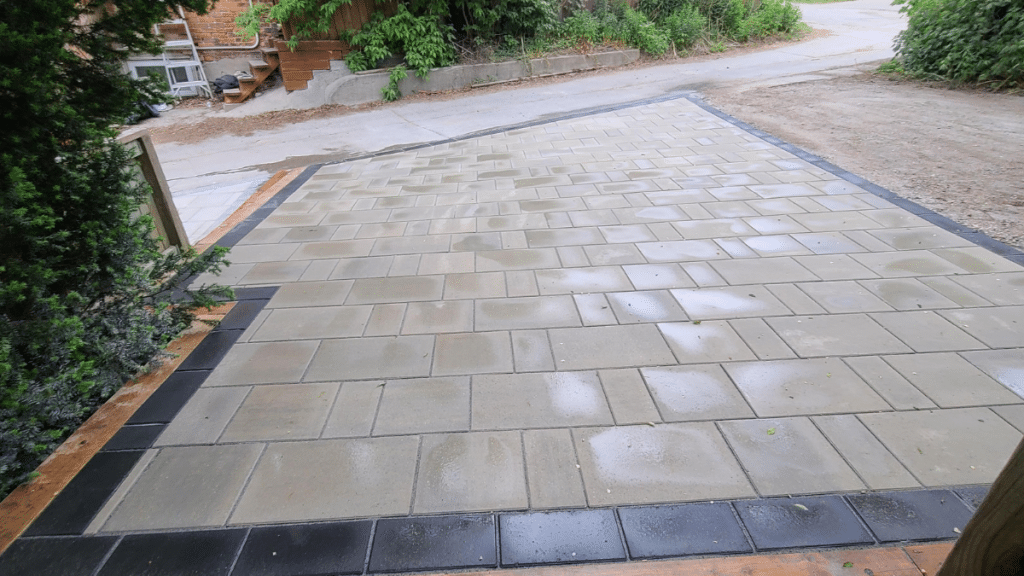When it comes to upgrading your backyard, choosing the right surface material is a major decision that affects both function and aesthetics. Whether you’re planning a patio, a walkway, or a full outdoor living space, two popular contenders often come to the forefront: interlocking pavers and poured concrete. Both options come with their own set of strengths, but one may suit your needs better than the other.
If you’re weighing the pros and cons of each material, and want to find out the cost of interlocking your backyard, there are important design and maintenance factors to consider before calling in the pros.
Appearance Matters: Style and Flexibility
The visual impact of your backyard matters — especially if you see the space as an extension of your home. In terms of aesthetics, interlocking pavers offer a level of creativity that concrete simply can’t match. Available in a variety of colors, textures, shapes, and patterns, pavers allow for truly custom designs. Whether you want a traditional cobblestone effect or a sleek modern look, there’s a solution that fits your taste.
Concrete, on the other hand, presents a clean and uniform surface. While stamped or stained concrete can mimic the look of stone or tile, the overall design flexibility remains limited compared to the modular approach of interlocking systems. Once poured and set, concrete doesn’t allow for much alteration or personalization.
Drainage and Weather Resistance
Outdoor surfaces must handle the challenges of changing weather conditions. Interlocking pavers are designed with small gaps between each unit, which means water can drain through the spaces into the base layer below. This not only reduces the risk of surface water buildup but also minimizes issues like puddling and frost damage during winter.
In contrast, concrete is a solid slab that doesn’t allow water to escape as easily. Even with a slight slope for runoff, standing water can lead to cracking over time. Freeze-thaw cycles in colder climates are especially tough on poured concrete, as expanding moisture causes stress that leads to visible deterioration.
Repairs and Maintenance
No outdoor material is completely maintenance-free, but interlocking pavers are often easier to manage long-term. If one section gets stained, chipped, or shifts out of place, individual pavers can be lifted and replaced without disturbing the surrounding area. This localized approach to repair is fast, affordable, and preserves the overall look of your space.
Poured concrete, on the other hand, poses a bigger challenge. Cracks, discoloration, or surface damage usually require patching, resurfacing, or even full replacement. Matching the color and texture of a new section to an existing slab is often difficult, making repairs more visible and disruptive.
Durability and Lifespan
Backyards see a lot of action — from heavy furniture and foot traffic to vehicles in some cases. Interlocking pavers are incredibly strong and built to handle high loads without cracking. Properly installed on a compacted base, they can last for decades with minimal wear.
While concrete can also be long-lasting, it’s more vulnerable to cracking, especially if not poured and cured correctly. Even with reinforcement, extreme temperatures or soil movement beneath the surface can lead to breakage. Over time, these cracks not only affect the appearance but can also compromise structural integrity.
Cost Comparison: Upfront and Over Time
Concrete is generally more affordable at the outset. The process of pouring and finishing a concrete slab is less labor-intensive and typically takes less time than laying individual pavers. For homeowners working with a tight budget, concrete might seem like the logical option.
However, interlocking pavers can offer better value in the long run. Their longevity, lower maintenance needs, and ease of repair often make them the more cost-effective choice over time. Plus, the added curb appeal can increase property value — an important factor if resale is on your horizon.
Pros and Cons at a Glance
Interlocking Pavers – Advantages:
- Highly customizable in design and color
- Excellent drainage and winter resilience
- Easy to repair and replace individually
- Long-lasting and durable under pressure
Concrete – Advantages:
- Lower initial cost
- Smooth, clean finish ideal for minimalist designs
- Faster installation for large, simple areas
Which One Is Right for You?
Every backyard is unique, and the best surface material depends on your priorities. If you’re aiming for a refined look, long-term durability, and easy repairs, interlocking pavers are often the smarter investment. They combine visual appeal with practicality in a way few other materials can.
On the other hand, if simplicity and short-term affordability are your main concerns, concrete could be a reasonable choice — especially in regions with mild weather and minimal ground movement.
No matter which route you choose, working with a professional installer ensures that your project is built to last. From preparing a solid base to choosing the right finish, expert guidance can help you achieve the backyard of your dreams.
